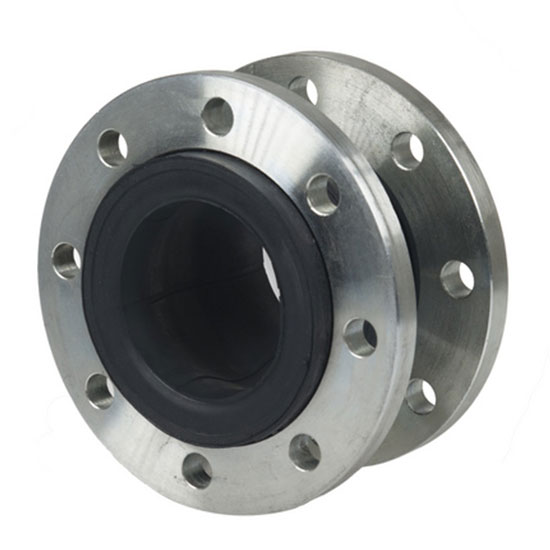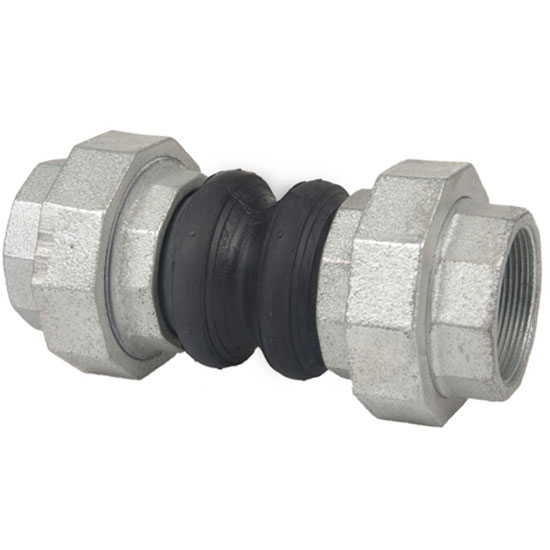Rubber expansion joints
Read more
In dynamic pipeline systems where pressure fluctuations, temperature changes and structural vibrations are present, rubber expansion joints serve as essential protective components. They are designed to compensate for thermal expansion, absorb mechanical stress and reduce the transmission of vibrations and noise.
These elements improve the reliability and lifespan of piping systems while simplifying installation and maintenance. ZETKAMA offers robust, tested solutions in the form of flanged rubber expansion joints and threaded flexible expansion joints, which meet international mechanical and dimensional standards and are suitable for use in heating, ventilation, shipbuilding and general industrial applications.
Structure and materials ensuring long-term performance
ZETKAMA expansion rubber joints are manufactured from EPDM rubber reinforced with nylon cord, which provides a combination of elasticity and mechanical strength. The EPDM material ensures resistance to a wide range of neutral and industrial fluids, and supports continuous operation at temperatures up to +100°C. The rubber body is resistant to wear, aging and fatigue under dynamic loads, and is shaped to allow multiple types of deflection without damaging the structure of the pipeline.
The flanged version – ZETKAMA Fig. 700 – is equipped with galvanized carbon steel flanges and retaining rings. This design ensures tight and stable connection to adjacent flanged pipeline elements, and protects against corrosion in standard industrial conditions. The threaded version – ZETKAMA Fig. 701 – features galvanized iron threaded ends and union ring nuts. These ensure tightness and allow for quick installation in threaded pipe systems, especially in smaller-diameter installations such as HVAC or compressed air systems.
Nominal sizes, pressure classes and operating conditions
ZETKAMA rubber expansion joints are available in multiple diameters and pressure classes to meet the needs of varied industrial systems:
- Fig. 700 (flanged):
– Nominal diameters: DN32–DN300 (PN16), DN350–DN600 (PN10)
– Max. operating temperature: +100°C - Fig. 701 (threaded):
– Nominal diameters: DN20–DN80
– Nominal pressure: PN16
– Max. operating temperature: +100°C
Connection dimensions conform to standardized norms:
- Flanged ends in Fig. 700 follow EN 1092-2
- Threaded ends in Fig. 701 follow ISO 228-1 NPT
This ensures compatibility with other components in pressure systems and guarantees easy integration with existing installations.
Deflection capabilities and vibration absorption
One of the key benefits of any flexible expansion joint is its ability to absorb pipeline movement in multiple directions. ZETKAMA’s designs offer reliable compensation for:
- Axial compression and elongation – movement generated by temperature-related pipe expansion or contraction. For Fig. 700, compression ranges from 10 mm (DN32) up to 30 mm (DN600), while elongation ranges from 6 mm to 14 mm. Fig. 701 allows a constant 22 mm compression and 6 mm elongation across all diameters.
- Lateral deflection – offset due to installation tolerances or structural shifts. Fig. 700 offers between 10 and 25 mm of lateral movement, depending on DN, and Fig. 701 maintains a constant 22 mm.
- Angular deflection – rotation between pipe ends. Fig. 700 allows between 8° and 25°, while Fig. 701 compensates between 15° and 30°, depending on size.
These mechanical properties protect the pipeline against stress concentrations, prevent premature damage to rigid elements such as pumps and valves, and reduce the transmission of noise and vibration across the structure.
Pressure-temperature correlation and safe operation
The pressure resistance of the rubber expansion joints is temperature-dependent. For DN20–DN80 (Fig. 701) and DN32–DN100 (Fig. 700), maximum allowable working pressure decreases as operating temperature increases, following the curve below:
| Operating Temperature | Max. Allowable Pressure |
| 50°C | 16.0 bar |
| 60°C | 12.4 bar |
| 70°C | 10.0 bar |
| 80°C | 7.5 bar |
| 90°C | 6.5 bar |
| 100°C | 5.2 bar |
These values apply to Group 2 gases and are determined according to EN guidelines. Proper application of the product requires verifying pressure and temperature compatibility with the operating medium.
Applications and media compatibility
ZETKAMA rubber expansion joints are designed for systems transporting:
- Drinking water
- Industrial water
- Glycol
- Compressed air (Group 2 gases)
- Neutral, non-aggressive fluids
These joints are commonly used in:
- Shipbuilding – compensating for structural vibrations and movement in marine environments
- Heating systems – especially those with thermal expansion due to temperature cycling
- Refrigeration and air conditioning – where flexible connections reduce the transmission of vibrations from compressors
- General industrial applications – wherever pipeline dynamics require flexible, durable compensation
It is essential to ensure that the selected size, pressure class and material variant are appropriate for the specific medium and working conditions, as not all configurations are suitable for every application.
Proven functionality and simplified installation
ZETKAMA rubber expansion joints are designed to operate in any working position. Their simple structure allows fast assembly and disassembly without the need for special tools or procedures. By eliminating mechanical strain, reducing noise and increasing installation flexibility, they contribute to the longevity of the entire piping system. The long service life of these joints is ensured by their high elasticity, thermal resistance and mechanical integrity under repeated dynamic loads. Their use allows operators to minimize system wear, avoid unplanned downtimes and ensure the stability of installations under pressure.
Certified quality and dimensional compliance
ZETKAMA’s expansion joints rubber are manufactured under a certified quality management system. They comply with mechanical and dimensional standards:
- EN 1092-2 for flanged connections
- ISO 228-1 NPT for threaded connections
All mechanical parameters, deflection values, and operating limits are documented in detailed technical datasheets. The use of these joints in any system should be preceded by verification of compatibility with medium, pressure, temperature, and connection type, as specified by ZETKAMA. With tested durability, standardized construction, and excellent compensating properties, ZETKAMA’s rubber expansion joints deliver proven functionality across multiple sectors. Whether used to manage thermal expansion, dampen vibration, or allow structural flexibility, they represent a dependable solution for dynamic pipeline systems. Every joint is engineered for long-term operation and documented performance, ensuring reliability where system protection is essential.

